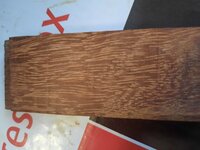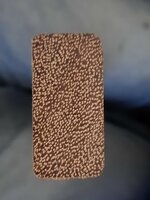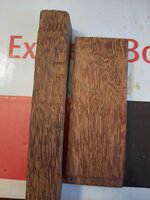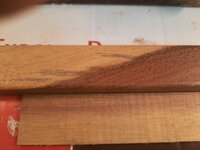You are using an out of date browser. It may not display this or other websites correctly.
You should upgrade or use an alternative browser.
You should upgrade or use an alternative browser.
Help identify this wood
- Thread starter Madman1978
- Start date
Signed-In Members Don't See This Ad
Signed-In Members Don't See This Ad
KMCloonan
Member
Can you provide one other view, 90 degree off from this side? (rotate the blank 90 degrees)
ed4copies
Local Chapter Manager
Could be red palm, usually the lines are dark though.
Amanap
Member
Looks like some type of palm, not black and doesn't look like red. I made some blanks from a Chinese Weeping palm that were similar to the one pictured but not as dark. I am thinking palm but not sure what species.I need a bit of help to identify this species
Madman1978
Member
Here is the end grain and a side by side with a red palm blank
I have no clue what this but I can say grain is is cool!
I salvaged a futon. These were the slots in each half. Back and Bottom. Some of the longer parts were from maple. I have a couple of 6 foot by 4 inches. I hope I can use them for something. These pieces are 7/8x 1 1/2 x 24 long I will have about 30 or so when done.
I have no clue what this but I can say grain is is cool!
I salvaged a futon. These were the slots in each half. Back and Bottom. Some of the longer parts were from maple. I have a couple of 6 foot by 4 inches. I hope I can use them for something. These pieces are 7/8x 1 1/2 x 24 long I will have about 30 or so when done.
Attachments
leehljp
Member Liaison
It sure looks like palm but I haven't seen that color before in palm.
I got a palm log this week end that was 8 to 9 inches in diameter and it is primarily blond in color. Close to the outside edge of 1 to 1 1/2 inches, the lines are black like black palm, but towards the center, those lines become similar in color (blond) to the wood/pulp VERY dense and hard.
That said, I had some wood when I was in Japan that looked very much like that, and on the ends too, that was not palm at all. I will look and search to see if I can find it, and if I have a name on it. I doubt that it was a Japanese wood as I purchased much of my wood at a chain hobby store (Tokyu Hands) with lots of wood imports. Might take me a day or so to find it.
I'm Thinking, I'm thinking! . . . In palm wood, the capillaries are most always darker, Or at least the same color than the surrounding wood. In the end of the wood in your photo, the capillaries are lighter, which is generally indicative of a normal wood species. I will check my stock from long ago.
It looks like Japanese Red Palm wood EXCEPT in the photos the capillaries are darker
I got a palm log this week end that was 8 to 9 inches in diameter and it is primarily blond in color. Close to the outside edge of 1 to 1 1/2 inches, the lines are black like black palm, but towards the center, those lines become similar in color (blond) to the wood/pulp VERY dense and hard.
That said, I had some wood when I was in Japan that looked very much like that, and on the ends too, that was not palm at all. I will look and search to see if I can find it, and if I have a name on it. I doubt that it was a Japanese wood as I purchased much of my wood at a chain hobby store (Tokyu Hands) with lots of wood imports. Might take me a day or so to find it.
I'm Thinking, I'm thinking! . . . In palm wood, the capillaries are most always darker, Or at least the same color than the surrounding wood. In the end of the wood in your photo, the capillaries are lighter, which is generally indicative of a normal wood species. I will check my stock from long ago.
It looks like Japanese Red Palm wood EXCEPT in the photos the capillaries are darker
Last edited:
KMCloonan
Member
I was gonna say lacewood, having only the one side to view, so I asked for the second side - it's not lacewood, and I don't know what it is. Not a lot of help coming from me today.
PatrickR
Member
If you know the country of origin for the futon that would help. This kind of item would probably be made from a local wood. One without a lot of commercial value. It could be very hard to identify exactly, as it may not be a type that is commonly exported.
Madman,
Have you tried turning it? Many years ago I was given some Ipe. This strongly reminds me of it. Rather heavy, very hard, turned OK, but not easy, downright difficult to sand, took a long time, had to change sandpaper several times just for one pen. That was enough of that stuff for me, never again! Practical use for this stuff is decking material for flatbed trailers. The wood I was given was leftover from replacement deck material for a flatbed trailer.
Charlie
Have you tried turning it? Many years ago I was given some Ipe. This strongly reminds me of it. Rather heavy, very hard, turned OK, but not easy, downright difficult to sand, took a long time, had to change sandpaper several times just for one pen. That was enough of that stuff for me, never again! Practical use for this stuff is decking material for flatbed trailers. The wood I was given was leftover from replacement deck material for a flatbed trailer.
Charlie
TellicoTurning
Member
My first thought was IPE also... if it is, be careful... I turned some Beeswing IPE a while back and broke out all over from the dust.
PatrickR
Member
Here is ipe end grain (from wood finder). Not a good match.

Madman1978
Member
I have not turned any yet. I have cut some on the band saw and it is quite dense. I am going to use some for a knife handle this week.
Madman1978
Member
I do not know where the futon was produced. I do know 4 rails are maple segmented together.If you know the country of origin for the futon that would help. This kind of item would probably be made from a local wood. One without a lot of commercial value. It could be very hard to identify exactly, as it may not be a type that is commonly exported.
PatrickR
Member
That's interesting.I do not know where the futon was produced. I do know 4 rails are maple segmented together.
Madman1978
Member
hooked
Member
What about Merbau? Common manufacturing material in Southeast Asia.
 www.bellforestproducts.com
www.bellforestproducts.com

Merbau Exotic Wood Blanks & Turning Wood | Bell Forest Products
Merbau Wood Blanks, Merbau Turning Blanks, hobby wood and instrument wood. Buy Exotic Wood, Birdseye Maple and Curly Maple (Tiger Maple) direct from Bell Forest Products
Madman1978
Member
That is almost spot onWhat about Merbau? Common manufacturing material in Southeast Asia.
Merbau Exotic Wood Blanks & Turning Wood | Bell Forest Products
Merbau Wood Blanks, Merbau Turning Blanks, hobby wood and instrument wood. Buy Exotic Wood, Birdseye Maple and Curly Maple (Tiger Maple) direct from Bell Forest Productswww.bellforestproducts.com
leehljp
Member Liaison
That is not palm. Merbau = Kwila I think that is what I purchased when overseas.Look two-tone!
Last edited:
Madman1978
Member
Thank you all for your input! I will say that this wood will make beautiful Knife scales and pens!
PatrickR
Member
Merbau or afzelia. My bet is afzelia when comparing face and end grain.
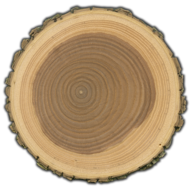 www.wood-database.com
www.wood-database.com
afzelia end grain

Merbau end grain

Afzelia | The Wood Database (Hardwood)
afzelia end grain
Merbau end grain

